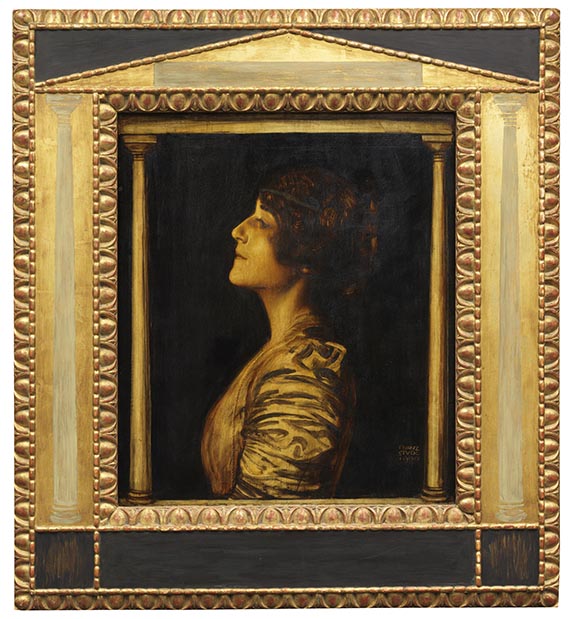360
Franz von Stuck
Weibliches Porträt (Mary Stuck), 1900.
Oil on panel
Estimate:
€ 25,000 / $ 26,750 Sold:
€ 76,200 / $ 81,534 (incl. surcharge)
Weibliches Porträt (Mary Stuck). 1900.
Oil on panel.
Lower right signed and dated. Inscribed "T. S 115" by hand on the reverse and with an old, fragmentarily preserved label that is typographically inscribed. 98 x 89 cm (38.5 x 35 in).
In the original frame.
• Characteristic portrait of the artist's wife in Renaissance style.
• As muse, model and manager, Mary Lindpaintner was one of the key figures in Stuck's creation.
• Elegantly reduced earthen tones as homage to his wife.
• Stuck's female portraits rare among his most sought-after works on the auction market.
PROVENANCE: Collection of Sigmund Kann, Prague (presumably acquired in 1927, with the hand-written entry on the reverse).
Presumably collection of Dr. Ernst Kann, Prague (presumbaly inherited from the above in 1931).
Collection of Alexander Kann, Prague/Sydney (presumbaly inherited from the above, with the hand-written ownershuip note on the reverse, until 1969: presumably Weinmüller).
Private collection Saarland (acquired before 1994).
EXHIBITION: VIII. Internationale Kunstausstellung im Königl. Glaspalast, Munich, June 1, 1901 - late Oct. 1901, no. 1685 ("Studienkopf (auf schwarzem Grund)", for sale).
LITERATURE:
Heinrich Voss, Franz von Stuck 1863-1928, Werkkatalog der Gemälde mit einer Einführung in seinen Symbolismus, Munich 1973, no. 215 (here with wrong dims: 58 x 50 cm).
Fritz von Ostini, Franz von Stuck, in: Die Kunst für Alle, vol. 19, issue 2, October 1903, fig. p. 51 ("Porträtstudie").
Fritz von Ostini, Franz von Stuck. Das Gesamtwerk, Munich 1909, p. 85 ("Profilstudie").
Neumeister vorm. Adolf Weinmüller, auction on November 19 - 22, 1969, no. 2203 (fig. plate 117, "Damenporträt").
Oil on panel.
Lower right signed and dated. Inscribed "T. S 115" by hand on the reverse and with an old, fragmentarily preserved label that is typographically inscribed. 98 x 89 cm (38.5 x 35 in).
In the original frame.
• Characteristic portrait of the artist's wife in Renaissance style.
• As muse, model and manager, Mary Lindpaintner was one of the key figures in Stuck's creation.
• Elegantly reduced earthen tones as homage to his wife.
• Stuck's female portraits rare among his most sought-after works on the auction market.
PROVENANCE: Collection of Sigmund Kann, Prague (presumably acquired in 1927, with the hand-written entry on the reverse).
Presumably collection of Dr. Ernst Kann, Prague (presumbaly inherited from the above in 1931).
Collection of Alexander Kann, Prague/Sydney (presumbaly inherited from the above, with the hand-written ownershuip note on the reverse, until 1969: presumably Weinmüller).
Private collection Saarland (acquired before 1994).
EXHIBITION: VIII. Internationale Kunstausstellung im Königl. Glaspalast, Munich, June 1, 1901 - late Oct. 1901, no. 1685 ("Studienkopf (auf schwarzem Grund)", for sale).
LITERATURE:
Heinrich Voss, Franz von Stuck 1863-1928, Werkkatalog der Gemälde mit einer Einführung in seinen Symbolismus, Munich 1973, no. 215 (here with wrong dims: 58 x 50 cm).
Fritz von Ostini, Franz von Stuck, in: Die Kunst für Alle, vol. 19, issue 2, October 1903, fig. p. 51 ("Porträtstudie").
Fritz von Ostini, Franz von Stuck. Das Gesamtwerk, Munich 1909, p. 85 ("Profilstudie").
Neumeister vorm. Adolf Weinmüller, auction on November 19 - 22, 1969, no. 2203 (fig. plate 117, "Damenporträt").
In his work, Franz von Stuck created an artistic program that drew on antiquity on the one hand and a revival of Italian Renaissance on the other. These two art heydays and their respective significance for contemporary perception, not only permeated his artistic work, but also extended to the staging of his person as a painter-prince, who revived these high times of artistic production around 1900. He created a type of portrait with clear references to early Italian Renaissance. He revisited Sandro Botticelli's depictions of his model Simonetta Vespucci in profile with artfully draped hair with gold hoops and pearls in his female portraits made in the late 1890s. The profile depiction of Florentine Renaissance was based on portraits of Roman coins and side reliefs. In 1892, he visited Max Klinger in Rome and used his studio for some time - this year also saw the founding of the Munich Secession, for which he designed the poster with the head of Athena in profile in an octagon. His wife Mary Lindpaintner (1865-1929), widow of the Munich doctor Julius Lindpaintner, ultimately became his number one muse and model. The wealthy, educated and well-connected American helped him on his path to the high society, a path he had already pursued since 1895, when he was appointed professor and which culminated in the construction of the prestigious villa in 1887/98. Stuck also emphasized his regal ambitions in the portrait of his wife, who is framed by the slender columns beneath a portico. The reduced color palette in ochre, black and brown tones also refers to the size of the portrait and is to be understood as an allusion to ancient art theory in its maximum expressiveness with minimal means. Despite the minimal movement, her slightly upwardly turned head effectively emphasizes the noble aura of a representative wife, who played a considerable role in Stuck's success. [KT]
360
Franz von Stuck
Weibliches Porträt (Mary Stuck), 1900.
Oil on panel
Estimate:
€ 25,000 / $ 26,750 Sold:
€ 76,200 / $ 81,534 (incl. surcharge)




 Lot 360
Lot 360 

